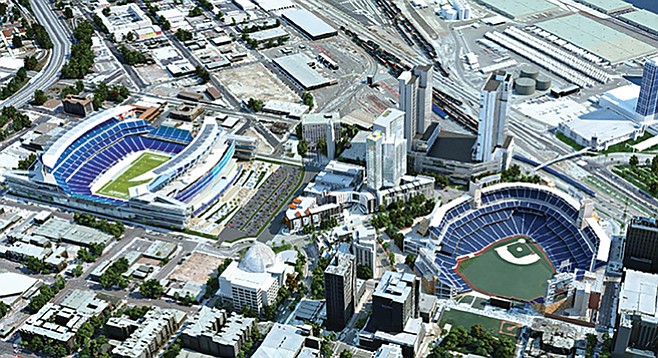 Facebook
Facebook
 X
X
 Instagram
Instagram
 TikTok
TikTok
 Youtube
Youtube

The San Diego County Taxpayers Association today (August 22) stated its opposition to the Chargers proposal for a subsidized stadium downtown. Stated the association: "San Diego should not raise taxes to subsidize a billion-dollar corporation; increases to the hotel tax should be utilized for critical city services, like street repairs and infrastructure improvements."
The study found that even under the most optimistic assumptions, "The City of San Diego would likely have to service debt from the general fund, which pays for a wide range of public services, in order to maintain its credit ratings and avoid higher financing charges for future debt."
The Chargers initiative would raise the hotel tax from 10.5 percent (realistically 12.5 percent) to 16.5 percent. The money would go to paying debt on the subsidized stadium downtown. The combined stadium/convention-center — convadium expansion would cost $1.8 billion, according to the Chargers. But if interest on the bonds is included, the cost balloons to $2.3 billion, says the association. The convention-center expansion part of the project would generate merely $2.3 million a year in hotel-tax revenue, compared to $67 million in annual public costs.
The study exposes optimistic assumptions of the Chargers plan. For example, moving the MTS bus yard would cost $70 million to $80 million. As a result, bus fares would have to go up. Further, "the City of San Diego has approximately $50 million in outstanding debt from the renovation of Qualcomm Stadium in 1997. The approximate $4.9 million in annual debt service will continue for another ten years through fiscal year 2026 and is not covered by the Chargers ballot measure."
The Chargers lease agreement allows for early termination of the lease, and if the team exercised that option, the city would assume debt liability that would not be covered by the exit fee required of the Chargers. The association summarizes a number of economists' studies showing conclusively that the subsidization of stadiums does not lead to economic growth of a city.


The San Diego County Taxpayers Association today (August 22) stated its opposition to the Chargers proposal for a subsidized stadium downtown. Stated the association: "San Diego should not raise taxes to subsidize a billion-dollar corporation; increases to the hotel tax should be utilized for critical city services, like street repairs and infrastructure improvements."
The study found that even under the most optimistic assumptions, "The City of San Diego would likely have to service debt from the general fund, which pays for a wide range of public services, in order to maintain its credit ratings and avoid higher financing charges for future debt."
The Chargers initiative would raise the hotel tax from 10.5 percent (realistically 12.5 percent) to 16.5 percent. The money would go to paying debt on the subsidized stadium downtown. The combined stadium/convention-center — convadium expansion would cost $1.8 billion, according to the Chargers. But if interest on the bonds is included, the cost balloons to $2.3 billion, says the association. The convention-center expansion part of the project would generate merely $2.3 million a year in hotel-tax revenue, compared to $67 million in annual public costs.
The study exposes optimistic assumptions of the Chargers plan. For example, moving the MTS bus yard would cost $70 million to $80 million. As a result, bus fares would have to go up. Further, "the City of San Diego has approximately $50 million in outstanding debt from the renovation of Qualcomm Stadium in 1997. The approximate $4.9 million in annual debt service will continue for another ten years through fiscal year 2026 and is not covered by the Chargers ballot measure."
The Chargers lease agreement allows for early termination of the lease, and if the team exercised that option, the city would assume debt liability that would not be covered by the exit fee required of the Chargers. The association summarizes a number of economists' studies showing conclusively that the subsidization of stadiums does not lead to economic growth of a city.
Comments